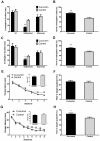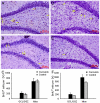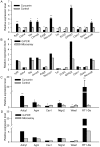Curcumin enhances neurogenesis and cognition in aged rats: implications for transcriptional interactions related to growth and synaptic plasticity
- PMID: 22359574
- PMCID: PMC3281036
- DOI: 10.1371/journal.pone.0031211
Curcumin enhances neurogenesis and cognition in aged rats: implications for transcriptional interactions related to growth and synaptic plasticity
Abstract
Background: Curcumin has been demonstrated to have many neuroprotective properties, including improvement of cognition in humans and neurogenesis in animals, yet the mechanism of such effects remains unclear.
Methodology: We assessed behavioural performance and hippocampal cell proliferation in aged rats after 6- and 12-week curcumin-fortified diets. Curcumin enhanced non-spatial and spatial memory, as well as dentate gyrate cell proliferation as compared to control diet rats. We also investigated underlying mechanistic pathways that might link curcumin treatment to increased cognition and neurogenesis via exon array analysis of cortical and hippocampal mRNA transcription. The results revealed a transcriptional network interaction of genes involved in neurotransmission, neuronal development, signal transduction, and metabolism in response to the curcumin treatment.
Conclusions: The results suggest a neurogenesis- and cognition-enhancing potential of prolonged curcumin treatment in aged rats, which may be due to its diverse effects on genes related to growth and plasticity.
Conflict of interest statement
Figures






Similar articles
-
Effects of curcumin on short-term spatial and recognition memory, adult neurogenesis and neuroinflammation in a streptozotocin-induced rat model of dementia of Alzheimer's type.Behav Brain Res. 2017 Sep 29;335:41-54. doi: 10.1016/j.bbr.2017.08.014. Epub 2017 Aug 8. Behav Brain Res. 2017. PMID: 28801114
-
Curcumin treatment leads to better cognitive and mood function in a model of Gulf War Illness with enhanced neurogenesis, and alleviation of inflammation and mitochondrial dysfunction in the hippocampus.Brain Behav Immun. 2018 Mar;69:499-514. doi: 10.1016/j.bbi.2018.01.009. Epub 2018 Feb 15. Brain Behav Immun. 2018. PMID: 29454881 Free PMC article.
-
Bisphenol-A Mediated Inhibition of Hippocampal Neurogenesis Attenuated by Curcumin via Canonical Wnt Pathway.Mol Neurobiol. 2016 Jul;53(5):3010-3029. doi: 10.1007/s12035-015-9197-z. Epub 2015 May 12. Mol Neurobiol. 2016. PMID: 25963729
-
Neurogenesis and neuroprotection in postischemic brain neurodegeneration with Alzheimer phenotype: is there a role for curcumin?Folia Neuropathol. 2015;53(2):89-99. doi: 10.5114/fn.2015.52405. Folia Neuropathol. 2015. PMID: 26216111 Review.
-
Hippocampal learning, memory, and neurogenesis: Effects of sex and estrogens across the lifespan in adults.Horm Behav. 2015 Aug;74:37-52. doi: 10.1016/j.yhbeh.2015.05.024. Epub 2015 Jun 27. Horm Behav. 2015. PMID: 26122299 Review.
Cited by
-
Metabolic complications of psychotropic medications in psychiatric disorders: Emerging role of de novo lipogenesis and therapeutic consideration.World J Psychiatry. 2024 Jun 19;14(6):767-783. doi: 10.5498/wjp.v14.i6.767. eCollection 2024 Jun 19. World J Psychiatry. 2024. PMID: 38984346 Free PMC article. Review.
-
Curcumin rescues aging-related loss of hippocampal synapse input specificity of long term potentiation in mice.Neurochem Res. 2013 Jan;38(1):98-107. doi: 10.1007/s11064-012-0894-y. Epub 2012 Sep 26. Neurochem Res. 2013. PMID: 23011209
-
Neuroprotective and Neurological/Cognitive Enhancement Effects of Curcumin after Brain Ischemia Injury with Alzheimer's Disease Phenotype.Int J Mol Sci. 2018 Dec 12;19(12):4002. doi: 10.3390/ijms19124002. Int J Mol Sci. 2018. PMID: 30545070 Free PMC article. Review.
-
A Meta-Analysis of the Clinical Use of Curcumin for Irritable Bowel Syndrome (IBS).J Clin Med. 2018 Sep 22;7(10):298. doi: 10.3390/jcm7100298. J Clin Med. 2018. PMID: 30248988 Free PMC article.
-
Heme oxygenase 1-mediated neurogenesis is enhanced by Ginkgo biloba (EGb 761®) after permanent ischemic stroke in mice.Mol Neurobiol. 2014 Apr;49(2):945-56. doi: 10.1007/s12035-013-8572-x. Epub 2013 Oct 24. Mol Neurobiol. 2014. PMID: 24154866 Free PMC article.
References
-
- Calabrese V, Cornelius C, Mancuso C, Pennisi G, Calafato S, et al. Cellular stress response: a novel target for chemoprevention and nutritional neuroprotection in aging, neurodegenerative disorders and longevity. Neurochem Res. 2008;33:2444–2471. - PubMed
-
- Ng TP, Chiam PC, Lee T, Chua HC, Lim L, et al. Curry consumption and cognitive function in the elderly. Am J Epidemiol. 2006;164:898–906. - PubMed
-
- Kumar A, Naidu PS, Seghal N, Padi SS. Effect of curcumin on intracerebroventricular colchicine-induced cognitive impairment and oxidative stress in rats. J Med Food. 2007;10:486–494. - PubMed
-
- Ishrat T, Hoda MN, Khan MB, Yousuf S, Ahmad M, et al. Amelioration of cognitive deficits and neurodegeneration by curcumin in rat model of sporadic dementia of Alzheimer's type (SDAT). Eur Neuropsychopharmacol. 2009;19:636–647. - PubMed
MeSH terms
Substances
LinkOut - more resources
Full Text Sources
Medical
Molecular Biology Databases

